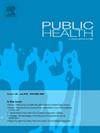Association between cardiovascular health, cancer and its prognosis: A prospective cohort study
IF 3.9
3区 医学
Q1 PUBLIC, ENVIRONMENTAL & OCCUPATIONAL HEALTH
引用次数: 0
Abstract
Objectives
Whether cardiovascular health (CVH) contributes to a reduced risk of cancer incidence and improves cancer prognosis remains unclear. This study aimed to evaluate the associations between CVH and risks of incident cancer and its subsequent CVD development and mortality.
Study design
Prospective cohort study.
Methods
This study obtained data from the UK Biobank study. CVH was assessed based on Life's Essential 8 (LE8) metrics. The primary outcome was incident cancer, which was defined using ICD-10 code C00-C97, excluding nonmelanoma skin cancer. The hazard ratio and 95 % confidence intervals between CVH and risk of incident cancer and risk of CVD and death after diagnosis of cancer were assessed using multistate Markov and Cox proportional hazards regression models. CVD includes coronary heart disease, atrial fibrillation, heart failure and stroke. The median follow-up period was 12.7 years, and follow-up ended on December 1, 2022.
Results
In total, 218,587 participants were eligible for analysis. During the follow-up, 27,603 (12.6 %) participants experienced incident cancer, 26,630 (12.2 %) experienced incident CVD and 12,399 (5.7 %) died. In fully-adjusted multi-state models, increased CVH scores were significantly associated with a reduced risk of incident cancer (HR per 10-point increment of CVH scores: 0.98, 95 % CI: 0.96–0.99), incident CVD (0.90, 0.89–0.91), and death (0.84, 0.81–0.87). Higher CVH scores were also associated with lower risks of incident CVD (0.90, 0.86–0.94) and death (0.89, 0.87–0.92) among cancer survivors. Notably, participants with a high Townsend deprivation index demonstrated the strongest associations of CVH with cancer and its prognosis, compared to those with low or intermediate levels of the index (P-for-interaction <0.05).
Conclusions
CVH is notably associated with the reduced risk of cancer and its subsequent development of CVD and death, which is more evident among participants with lower socioeconomic status. Our results highlight the potential of promoting LE8 adherence for primary and secondary prevention of cancer.

求助全文
约1分钟内获得全文
求助全文
来源期刊

Public Health
医学-公共卫生、环境卫生与职业卫生
CiteScore
7.60
自引率
0.00%
发文量
280
审稿时长
37 days
期刊介绍:
Public Health is an international, multidisciplinary peer-reviewed journal. It publishes original papers, reviews and short reports on all aspects of the science, philosophy, and practice of public health.
 求助内容:
求助内容: 应助结果提醒方式:
应助结果提醒方式:


